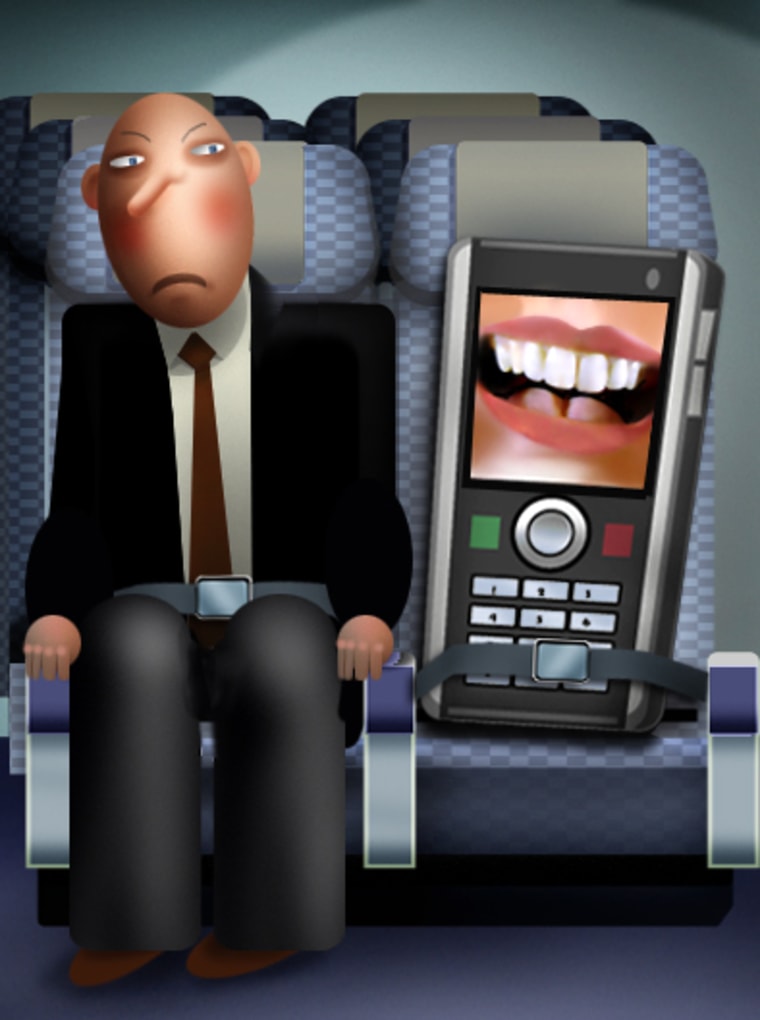Passengers on JetBlue's “BetaBlue” and on an Air France Airbus A318 jets have been doing it since mid-December.
It’s been going on for months on some flights operated by Qantas in Australia and on 10 Airbus jets operated by Dubai’s Emirates airline.
Soon, folks flying on American Airlines, Virgin America and Alaska Airlines, and on Europe's BMI, TAP and Ryanair, will be doing it too.
You can avert your eyes, or — if you have the right equipment — join right in. Soon there will be no escaping it: text messaging, e-mailing and Web surfing are about to become as common in the air as they are on the ground. So too will the etiquette issues associated with them. In the air, however, there will be a few new wrinkles.
For example, the service being tested right now on Air France and JetBlue allows those with cell phones or BlackBerry-type devices to send and receive text messages and e-mail. For those who want or need to be in touch with those on the ground, this might be a great time-saver. And cleaning out your inbox, taking time to thoughtfully compose and answer an e-mail message, or texting your sweetie about dinner plans will no doubt prove more entertaining than watching the in-flight movie, re-reading those magazines or making polite chit-chat with a boring seatmate.
However, those who have come to view an airplane trip as a rare chance to “close the door” and be electronically unavailable for a few hours may be understandably worried. If you can send and receive text messages and e-mails during a flight, then bosses, clients, friends and family members might expect you to use your flying time to stay in touch with them instead of sleeping, reading, dreaming, doing crossword puzzles, chatting up an interesting seatmate or figuring out how to pad your expense reports.
Surf’s up — way up
In the next few months, several airlines plan to roll out in-flight services that include broad Internet access. When that happens, in-flight electronic-etiquette issues will become even more complicated.
There are already stories of passengers who become upset when seated next to or nearby someone viewing violent or pornographic videos or other questionable material on laptops. This may become more of a problem once passengers, especially kids, can surf the Web from their seats. And what about travelers who open SKYPE or another VOIP program and start making calls?
Airlines and technology providers have been discussing these issues and are just beginning to work out policies and positions. Some may limit the services offered in-flight or block certain sites and content. Others seem to be taking a “let’s wait and see how it goes” approach.
American Airlines plans to begin testing its in-flight Internet service within the next few months. Using Aircell's air-to-ground broadband service, American will offer Web surfing, e-mail and VPN access. VOIP or SKYPE services will be prohibited, but so far no decisions have been made on what, if any, content might be blocked. Aircell's president, Jack Blumenstein, says, "We think decency, good sense and normal behavior will prevail in the use of in-flight Internet."
Virgin America plans to offer air-to-ground broadband on all flights sometime this year. “We currently do not have set plans to monitor content, but we are still evaluating how the system will be implemented,” airline spokesperson Abby Lunardini said. Lunardini doesn’t anticipate problems with passengers having full access to the Web. She acknowledges etiquette dictates that passengers are conscious of fellow passengers, adding, “if a guest was offended or having an issue with someone, our in-flight teams are trained to intervene and address the situation.”
And what about SKYPE and other VOIP services? Lunardini says the airline is still evaluating the issue. “Having a very noisy guest next to you is potentially an issue, so we’re considering this carefully.”
Phone home
In Paris, Air France is anxious to offer a full menu of in-flight options. The airline is currently testing a data and messaging service on one airplane and will soon begin a test of in-flight cell-phone service.
Airline spokesperson Marina Tymen says Air France was anxious to be the first airline to test this service, but says customer response will be carefully monitored and evaluated. Crewmembers will be taking notes and passengers will complete detailed questionnaires.
Tymen hopes passengers will regulate themselves when it comes to adjusting the length of their calls and the volume of their conversations, but says, “The crew will have to be very aware of the sound generated by the phone calls. We may have to say to the people ‘Can you not be so loud?’ or something like that.”
What happens if folks won’t pipe down? Charlie Pryor, a representative for OnAir, the company providing Air France’s cell-phone service, says while “the airlines are experts at managing the cabin environment,” technology offers some answers. “For example,” he says, “the cabin crew can turn the system to data only ... so passengers cannot use the voice function of their cell phones.
“The system can also be turned off altogether,” Pryor said. That’s one option he suspects some airlines might use on overnight or Sunday morning flights.
In-flight cell-phone service will certainly be popular, but Pryor says passengers needn’t worry too much about ending up on a plane with 120 seats and 120 cell-phone conversations going on all at once. “The technology allows a maximum of 12 simultaneous calls,” he said. If 12 people are talking on the phone at one time, the 13th person will receive a ‘network busy’ message on their phone, in exactly the same way as they would on the ground.”
Unfortunately, that technological “lid” won’t ensure peace and quiet for long. Pryor was quick to add that if demand for in-flight cell-phone use exceeds expectations, it’s easy to double capacity by adding an extra antenna.
